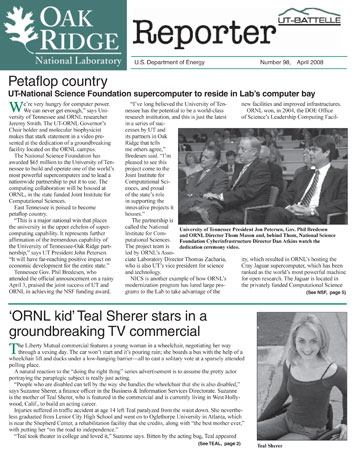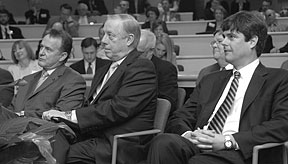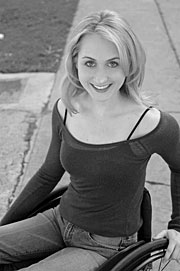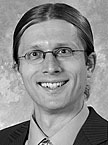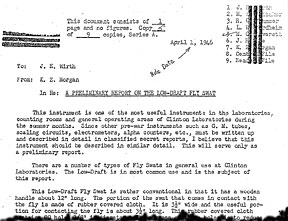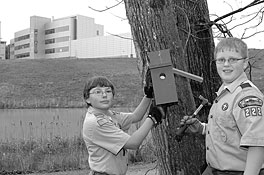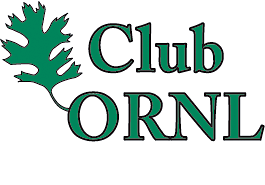 |
Number 98, April 2008 |
 Petaflop country
Petaflop country
UT-National Science Foundation supercomputer to reside in Lab’s computer bay
|
|
University of Tennessee President Jon Petersen, Gov. Phil Bredesen and ORNL Director Thom Mason and, behind Thom, National Science Foundation Cyberinfrastructure Director Dan Atkins watch the dedication ceremony video. |
We’re very hungry for computer power. We can never get enough,” says University of Tennessee and ORNL researcher Jeremy Smith. The UT-ORNL Governor’s Chair holder and molecular biophysicist makes that stark statement in a video presented at the dedication of a groundbreaking facility located on the ORNL campus.
The National Science Foundation has awarded $65 million to the University of Tennessee to build and operate one of the world’s most powerful supercomputers and to lead a nationwide partnership to put it to use. The computing collaboration will be housed at ORNL, in the state funded Joint Institute for Computational Sciences.
East Tennessee is poised to become petaflop country.
“This is a major national win that places the university in the upper echelon of supercomputing capability. It represents further affirmation of the tremendous capability of the University of Tennessee-Oak Ridge partnership,” says UT President John Petersen. “It will have far-reaching positive impact on economic development for the entire state.”
Tennessee Gov. Phil Bredesen, who attended the official announcement on a rainy April 3, praised the joint success of UT and ORNL in achieving the NSF funding award.
“I’ve long believed the University of Tennessee has the potential to be a world-class research institution, and this is just the latest in a series of successes by UT and its partners in Oak Ridge that tells me others agree,” Bredesen said. “I’m pleased to see this project come to the Joint Institute for Computational Sciences, and proud of the state’s role in supporting the innovative projects it houses.”
The partnership is called the National Institute for Computational Sciences. The project team is led by ORNL’s Associate Laboratory Director Thomas Zacharia, who is also UT’s vice president for science and technology.
NICS is another example of how ORNL’s modernization program has lured large programs to the Lab to take advantage of the new facilities and improved infrastructures.
ORNL won, in 2004, the DOE Office of Science’s Leadership Computing Facility, which resulted in ORNL’s hosting the Cray Jaguar supercomputer, which has been ranked as the world’s most powerful machine for open research. The Jaguar is located in the privately funded Computational Science Building, located next to JICS.
Lab Director Thom Mason described meeting Tennessee’s governor for the first time when Bredesen was a candidate for the post. That the governor is a physicist by schooling came as a good sign.
“Gov. Bredesen as a candidate took the challenge [to build a joint institute] and took a risk,” Thom said.
It is a risk that is paying off for the state. Another state-funded joint institute, the Joint Institute for Biological Sciences, was selected last year to house one of the Office of Science’s Bioenergy Research Centers. Two more joint institutes are planned: one for neutron sciences, adjacent to the Spallation Neutron Source, and a joint institute for advanced materials that is planned for the UT campus.
The new supercomputer system will be built and deployed in partnership with Cray and AMD, and it will be capable of nearly 1,000 trillion calculations a second (one petaflop/s) giving researchers the tools they need to conduct transformational research in a variety of fields including astrophysics, climate research, earth science and advanced materials. The system will also enable researchers to develop new knowledge and solutions in areas such as chemistry, biochemistry, particle physics, engineering and computer science.
“Researchers need increasingly powerful computing resources if they are to deliver the breakthroughs that society demands in climate science, energy research and other fields,” says Zacharia. “This award will guarantee that we are able to deliver those resources.”
The grant includes $30 million for computer hardware as well as $35 million toward operation of the system over the course of the next five years.
With those tools, researchers like Jeremy Smith will, as the NSF Office of Cyber Infrastructure Director Dan Atkins alliteratively expressed, “find knowledge needles in enormous data haystacks.”
Led by UT, the NICS partnership includes academia (Clemson, Duke, Florida State, Louisiana State, North Carolina State, Rice and Vanderbilt universities; the universities of Houston, Oklahoma, and Virginia; and Virginia Tech), current NSF resource providers (the National Center for Atmospheric Research, ORNL, and Texas Advanced Computing Center); a university consortium (Oak Ridge Associated Universities); and industrial partners (Cray and AMD).—Reported by Jay Mayfield and Bill Cabage ![]()
|
||
|---|---|---|
The Joint Institute for Computational Sciences, now home of the University of Tennessee and National Science Foundation supercomputing collaboration, wasn’t actually designed with the infrastructure necessary to house a supercomputer. |
 ‘ORNL kid’ Teal Sherer stars in a
groundbreaking TV commercial
‘ORNL kid’ Teal Sherer stars in a
groundbreaking TV commercial
|
|
Teal Sherer |
The Liberty Mutual commercial features a young woman in a wheelchair, negotiating her way through a vexing day. The car won’t start and it’s pouring rain; she boards a bus with the help of a wheelchair lift and ducks under a low-hanging barrier—all to cast a solitary vote at a sparsely attended polling place.
A natural reaction to the “doing the right thing” series advertisement is to assume the pretty actor portraying the paraplegic subject is really just acting.
“People who are disabled can tell by the way she handles the wheelchair that she is also disabled,” says Suzanne Sherer, a finance officer in the Business & Information Services Directorate. Suzanne is the mother of Teal Sherer, who is featured in the commercial and is currently living in West Hollywood, Calif., to build an acting career.
Injuries suffered in traffic accident at age 14 left Teal paralyzed from the waist down. She nevertheless graduated from Lenior City High School and went on to Oglethorpe University in Atlanta, which is near the Shepherd Center, a rehabilitation facility that she credits, along with “the best mother ever,” with putting her “on the road to independence.”
“Teal took theater in college and loved it,” Suzanne says. Bitten by the acting bug, Teal appeared in plays in Atlanta. She won a role in a TV movie, “Warm Springs,” about Franklin Delano Roosevelt’s first visits to the Georgia spa after being stricken with polio.
|
“Friends tell me all the time that they forget I’m in a wheelchair. They just forget.” |
Teal also drew the task of tutoring acclaimed British actor Kenneth Branagh, who played FDR, on how to wear leg braces and swim as if he didn’t have the use of his legs.
“He claimed he needed to see how I swim, but I prefer to believe it was a ploy to see me in my bathing suit,” she wrote in an article for New Mobility magazine.
“Warm Springs” won five Emmys out of 16 nominations; she got a peck on the cheek from Branagh. Teal has also acted in a TV pilot and continues to be an activist for the rights of the disabled. As communications director of the SAG Performers with Disabilities Committee, she has worked to open up acting jobs for actors with disabilities.
She is producing “The History of Bowling,” a satire written by disabled playwright Mike Ervin.
While in Atlanta she visited the Shepherd Center as a peer supporter.
In Liberty Mutual’s commercial series, good deeds and good decisions spawn a better world. Teal’s “Election” spot implies that there aren’t many valid reasons for neglecting one’s civic responsibility. They picked a good one to drive home the point about determination. “Disabled” really isn’t a word that describes Teal.
“Friends tell me all the time that they forget I’m in a wheelchair. They just forget,” Teal says in New Mobility. “It’s all about attitude and personality. No matter what your situation, if you have a great attitude, other people pick up on it.”
We might be seeing a lot of Teal between now and the November elections. View the entire commercial at http://whatsyourpolicy.com/videos.—B.C. ![]()
 ORNL welcomes three new Wigner fellows
ORNL welcomes three new Wigner fellows
|
|
Kardol |
Three new Wigner fellows have joined ORNL. The two-year postdoctoral fellowships, named for Eugene Wigner, a Nobel laureate and ORNL’s first science director, are awarded to some of the world’s top early career researchers.
Paul Kardol has been working with the Environmental Sciences Division’s Aimee Classen since February. He received his master’s degree in 2000 in landscape ecology-animal population biology from the University of Utrecht. Paul earned his doctorate in ecology in 2007 from the Netherlands Institute of Ecology, Wageningen University. Paul’s current research interests include rhizosphere interactions, plant-soil feedbacks and plant community dynamics and invasions under climate change. Outside of work, Paul enjoys biking (quite a challenge in Tennessee, he thinks), hiking, climbing and traveling to exotic and far-away countries.
|
Safa-Sefat |
Athena Safa-Sefat joined the Materials Sciences & Technology Division in December 2007. She is in the Correlated Electron Materials group, working with David Mandrus. She received her B.S. in 2001 and her Ph.D. in 2005 at McMaster University, Hamilton, Ontario, in solid state chemistry. Her doctorate thesis was on the magnetic and electronic transitions of vacancy-doped oxide materials. Athena worked as a postdoctoral fellow at Ames Laboratory, where her research focused on intermetallic crystals, their structures, and magnetic and transport properties. She has coauthored 20 publications. Athena’s current research interests include the syntheses of new and improved functional oxides in polycrystalline and single crystal forms. Outside of work, she enjoys outdoor activities, the company of friends and spending time with her dog, Max.
|
Lin |
Henry Lin joined the Biosciences Division, working with Ram Datar, in January 2008. He received his B.S. in 2002 in bioengineering from University of California, Berkeley, where he worked on the development of array-based microcantilever biosensors. Henry earned his doctorate in pathology in 2007 from the Keck School of Medicine at the University of Southern California, continuing the work with microcantilever biosensors and also developing a filter-based microdevice for enumeration and characterization of circulating tumor cells. Henry’s current research interests include the development of biosensors for diagnostic applications and research-enabling platforms to tackle complex biological problems such as metastasis. Outside of work, Henry enjoys cycling, running, hiking and playing basketball. ![]()
 Work closes east campus entry
Work closes east campus entry
Electrical upgrades to the privately funded facilities have closed White Oak Avenue to traffic for six months. The closing involves White Oak Avenue from the intersection of Southside Drive to the alley east of the Engineering Technology Facility, blocking the east approach to the ORNL campus.
Traffic entering and leaving the main ORNL campus should use the Fifth Street or First Street entrances. The work is expected to wrap up by July 31.
Also, effective April 11, the inbound traffic gates at the Bethel Valley Road vehicle entrances will be closed at 9 p.m. and opened at 4 a.m., daily. The portals will continue to be staffed, and the gates will be quickly opened for all badged employees. ![]()
 |
 Magnetic fields your neighbor can appreciate
Magnetic fields your neighbor can appreciate
Scientists often need to apply strong magnetic fields to the materials they study but find that stray magnetic fields wreak havoc with their (and their neighbors’) experiments. The Spallation Neutron Source has taken a big step toward solving this problem by commissioning the world’s first actively shielded magnet system specifically designed for neutron scattering.
The new magnet system is known as Slim SAM (shielded asymmetric magnet). It produces a central field of up to 5 tesla (T), which is modest compared with the strongest unshielded neutron magnets of 15 T; however, it has the advantages of very low stray field, an asymmetric field profile optimized for using polarized neutron beams and a compact size. Slim SAM has passed acceptance tests and is available for the next round of user proposals.
For those who demand both the strongest fields and active shielding, a 16-T actively shielded system has been designed and is under fabrication through a collaboration with the Paul Scherrer Institut, a neutron scattering facility in Switzerland. Delivery to SNS is scheduled for 2009.
Classified: Musca domestica control
|
Morgan’s report: “Rather conventional.” |
Shortly after World War II, famed ORNL health physicist Karl Z. Morgan was frustrated by classification officers’ tendency to classify nearly everything, even reports on commonly used instruments. So, in April 1946 he submitted a report on a frequently used apparatus, the “Low-Draft Fly Swat.”
“This rubber covered cloth contains 80 holes 1/8" in diameter. The purpose of these holes is to reduce the compression wave when swatting a fly. Otherwise the air concussion would help the fly on its take-off and would give him additional warning of imminent danger,” he wrote, explaining some of the physics behind the instrument.
Morgan submitted the report on April 1, 1946. The document was duly classified, presumably to prevent others from developing their own death-dealing device.
Morgan’s April Fools’ gag was turned up by ORNL History Room volunteers Steve Stow, Bill Yee and Charles Congdon, who posted the now declassified document on their bulletin board on its 62nd anniversary.
Earth Day: You can go back home
This year the Lab’s Earth Day celebration on April 22 includes a talk by Jeff Christian on the Near-Zero Energy Homes project, an alternative vehicle transportation show (i.e., hybrids, biofueled models, motorcycles, bicycles) and a tour of the Conference Center pond.
The pond was the center of activity for last year’s Earth Day, featuring the release of several indigenous fish and turtle species, including gar and
sliders. It’s hard to say how the gar took to the pond, but some of the sliders and painted turtles emerged on the first warm days of this spring, sunning themselves on the log structures placed for them in the pond.
The release anticipated a Lab program to reestablish native fish species in White Oak Creek. Mike Ryon, Kittie McCracken and James Scott have been reintroducing stripetail and snubnose darters, rock bass, striped shiners, bluntnose minnows and northern hog suckers back into the stream.
The species died out when water quality was affected during Cold War years, and even though water quality has vastly improved since then, thanks to pollution prevention efforts and riparian zone management, barriers downstream have prevented the fish from reentering the creek.
So the Environmental Sciences Division effort is helping them out. With any luck, the fish will reestablish their role in White Oak Creek’s original ecosystem.
|
|
|---|---|
With its open spaces, the Spallation Neutron Source is an ideal area for bluebirds. On March 29, members of Oak Ridge Boy Scout Troop 328 sacrificed a Saturday morning for a service project to install bluebird houses around the Chestnut Ridge site. Here, scout Marcus Bowling and cub scout Nick Bowling install a birdhouse with the Nanoscience Center in the background. |
|
—Assembled by Bill Cabage |
 Significant Event Awards mark outstanding efforts
Significant Event Awards mark outstanding efforts
Significant Event Awards were distributed recently to staff members for their outstanding accomplishments in research and operations. Congratulations to all.
Biological & Environmental Sciences
Release of the first State of the Carbon Cycle report: Anthony W. King, Gregg Marland, Thomas J. Wilbanks, Sherry B. Wright and Greg P. Zimmerman
Design, procurement and implementation of major systems upgrade for ORNL Distributed Active Archive Center for Biogeochemical Dynamics: Bruce E. Wilson, David Sill, Tammy Beaty, Ben McMurry, Giri Palanisamy and Suresh Santhan Vannan
Procurement Effort for BioEnergy Science Center: Mitzi B. Bailey
Business & Information Services
Support for 2007 Day of Science: Will Minter, Mike Bradley, Brenda Hackworth, Connie Sharpe and Greg Gruzalski
Computing & Computational Sciences
Successful Support of Supercomputing 2007 Conference: Linda Duncan
Successful completion of the Bombing Prevention and Capabilities Analysis Project: Richard C. Ward, Barbara G. Beckman, Daniel B. Koch, April D. McMillan, Kenneth W. Childs, Michael R. Moore and John B. Wilgen
Successful establishment of ORNL as the computational lead for the Defense Advanced Research Programs Agency Foundation Program, the next generation of socio-technical simulation: Steven Fernandez, Auroop Ganguly, Cathy Jiao, Amy Rose and Phil Coleman
Flow-path analysis resulting in multi-million dollar savings to the USAF: John R. Kirkpatrick
2007 ORNL phishing attack and cyber security response: Philip Arwood, Mark Floyd and Jeff Schibonski
Simulation aids development of first coal plants with near-zero emissions: Sreekanth Pannala
Energy & Engineering Sciences
Successful startup of the GNEP/AFCI Coupled End-to-End Demonstration of Spent Fuel Recycle Processing: Jeff Binder, Bob Jubin, Porter Bailey, Emory Collins, Gary Bell, Joe Giaquinto, Elisabeth Walker, Dennis Benker, Barry Spencer, Bill Del Cul, Kevin Felker and Ray Vedder
Showcase of the Commercial Motor Vehicle Roadside Technology Corridor: Gary Capps, Sheila A. Moore, Helmut K. Knee, Oscar Franzese, Phyllis J. Daley, Debbie T. Bain, Mary Beth Lascurain and Pat Hu
Contributions to the NA-21 Program Mission: Tim Wynn
Successful completion of the Mercury Intense Target Experiement design, development and operation in-beam at CERN in November 2007: V. B. Graves, D. E. Hobson and A. J. Carroll
Successful completion of the NCSX modular magnetic coil interface design (Level II DOE Milestone): Michael J. Cole
Environment, Safety, Health & Quality
Reduction of legacy compliance vulnerabilities in 9204-3 at ORNL/Y-12 by removal of excess equipment/materials and characterization/disposition of radioactive wastes: Laura Harvey, Mary Sue Hamilton, Mary Dunsmore, Claude Sampson, Lee Zevenbergen, Roger O’Dell, Scott Bowman, Jack Adams, Dennis Rice, Rich Utrera, Richard Peden and Stan Heath
Significant Expansion of National Voluntary Laboratory Accrediation Program accreditation for the ORNL Metrology Laboratory: M.L. Duncan, W.E. Wright, B.K. Sizemore, G.A. Strickland and A. J. Denton
Change of respirator selection options and inventory in response to safety concerns: Michael Sugarman
Facilities & Operations
Two years without a recordable injury on ORNL FDD construction work: J. Robert Ihle, Wayne Underwood, Richard Haun, Jeffrey Harrison and Kenneth Brown
Supervising hoisting and rigging operations: Stephen C. Rose
Management and coordination of Operations Security program, activities and events at ORNL: Janie A. Blackwell
Improved liquid nitrogen system implemented in SAP: Lori (Odie) Costanzo
Installation of the Remotely Operated Weapon System: Daron Keesee
Building 2010 (former ORNL cafeteria) demolition and disposition project: Steven L. Laman, Julia K. Hancock, Bryce A. Powers and Lance J. Mezga
First responder initial training and 911 dispatcher training for the control center assistants in the Laboratory Shift Superintendent team: J. S. Thomas, C.L. Daubenspeck, L.L. Dowdell, A.L. Martin, L.C. Wilkerson and J.W. Williams
Global Initiatives
Information system certification and accreditation activities: Sandra S. Goldston
New softcopy imagery capability: Brent Starr
Human Resources
Part-time Benefits Project: Tricia Bryant, Janice Ishee, Becky Parks, Deborah Alvaro, Rick Stephens, Michael Bjerke, Judith Hickman and Shane Tucker
ITER
U.S. ITER support to ITER International: Gregory Capps, Robert Wayne Steffey and Robyn Rose
Response to U.S. ITER budget crisis, 2008: Suzanne Herron, Jama Hill and Janet Bivens
Legal
Successful execution of a classified project vital to the national security: James N. Sumner, Jon Kreykes, Duane F. Starr, David F. Felde and Alan M. Parker
Nuclear Operations
Significant accomplishments in the implementation of reactor mechanical system improvements at the High Flux Isotope Reactor, including the deployment of new technologies: R. Scott Brackett, Patrick A. Tobin, Bennie H. Brewer II, Geoffrey G. Deichert, Thomas K. Roche, E. Dale Hickman, Raymond B. McKeown and Kenneth R. Houbre
Neutron Sciences
Completion of superconducting radio-frequency test facility keeps Spallation Neutron Source power ramp-up on track: Dan Stout, John Mammosser, Bill Stone, Mark Crofford, Dale Heidenreich, David Vandygriff, Derrick Williams, Matt Howell, Herb Strong, Tom Neustadt, Jason Stigal and Mike Dobiel
High Flux Isotope Reactor HB-4 time-of-flight testing and common casing redesign and installation: G. Brent Taylor, R. Tom Roseberry, Ron G. Maples, Stephen Kulan, Phil D. Ferguson, Erik Iverson, Lee Robertson, David G. Renfro, Bruce F. Siefken, Ed M. Ducko, George A. Barclay, Ben G. Rothrock, Carl J. Schepens, Eric L. Griffis, Keith B. Napier, Phong T. Nguyen, Young Soo Kwon and Donald H. Abercrombie
National Security
DHS Office of Bombing Prevention IED Technology Development Conference support:
Lara A. James, Bobbie R. Sweet, Kristy S. Herron, Ann B. Hasting, Linda S. Edwards, Shirley McKamey and Cheryl M. Edwards
Physical Sciences
Development of IBAD-based second-generation superconducting wires as part of the ORNL-SuperPower CRADA Team: M. Paranthaman, T. Aytug, A. Goyal, E.D. Specht, L. Heatherly and C. Cantoni
Acquisition of new Hight Field, 700-MHz nuclear magnetic resonance spectrometer: Edward W. Hagaman
Discovery of new short-lived alpha-emitters near the doubly magic nucleus 100Sn: Krzystof Rykaczewski, Robert Grzywacz, Carl Gross, Dan Shapira and Carrol Bingham
Breakthrough approach in gaining new fundamental understanding of the atomic origins of strength: Hongbin Bei and Easo George
Development of laser ion source technology for the Holifield Radioactive Ion Beam Facility: Yuan Liu, Charles Havener, Randy Vane and John Cole
Bettis irradiated bolt testing: Eric T. Manneschmidt, Robert G. Sitterson, Charles A. Baldwin and Robert N. Morris
 Atomistic detail
Atomistic detail
Potassium channel model lights the way for simulations of molecular machines
Scientists are using resources at the National Center for Computational Sciences to simulate in unprecedented detail the voltage-gated potassium channel, a membrane protein that responds to spikes of electricity by changing shape to allow potassium ions to enter a cell.
“The study will serve as a future road map for simulating, visualizing and elucidating the workings of molecular nanomachines,” says professor Benoît Roux of Argonne National Laboratory and the University of Chicago.
\ 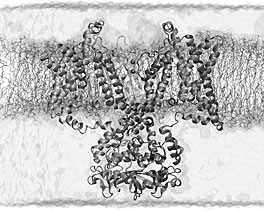 |
A visualization of the modeled three-dimensional structure of the potassium-channel protein, performed on the ORNL Jaguar supercomputer. |
In essence, a voltage-activated ion channel is a nanoscale device acting as an electric switch, he says. With University of Illinois at Urbana-Champaign researchers Klaus Schulten and Emad Tajkhorshid, Roux uses the Leadership Computing Facility at ORNL to model the channel in its open and closed states and determine the gating charge driving the change in conformation between the two states.
If the switch operates normally, the potassium channel opens when activated and closes when resting. But if gating malfunctions—and it can go awry in various ways—cardiovascular or neurological disease can result. The important functions of potassium channels in excitable cells make them good drug targets.
Roux’s team is using a computer program called Rosetta to predict the three-dimensional structure of the potassium-channel protein. For a given sequence of amino acids, Rosetta conducts a large-scale search for three-dimensional protein conformations that are especially low in free energy and assumes the native state is the one with the least free energy. The group found that simulations of the open and closed states are stable. Assessing stability is critical to supporting the model’s validity.
In a step toward achieving their long-term goal of understanding how membrane-associated molecular protein machines function, the researchers simulated the motion of all atoms in the system using a molecular dynamics code for parallel processing that was developed in Schulten’s lab.
The code, called NAMD, uses Newton’s laws and an energy function to simulate protein behavior in steps on the order of one femtosecond, or trillionth of a second. By looking at how the potassium channel moves in tiny, ultrafast increments, researchers can build a biologically meaningful picture of its dynamics.
Roux’s group received funding from the National Institutes of Health and an allocation of NCCS supercomputer time through a DOE program called INCITE (for Innovative and Novel Computational Impact on Theory and Experiment). In 2007 the researchers used about 2.5 million processor hours on the NCCS’s Cray XT Jaguar supercomputer to model the behavior of systems with up to 350,000 atoms. “We are in the process of unraveling the atomistic basis for the coupling between a voltage-gated channel and the transmembrane electric potential,” says Roux, whose group has received a 2008 INCITE grant of 3.5 million hours on Jaguar to continue the studies.—Dawn Levy ![]()
 Spring walks include invasive plants, reptile trap sites
Spring walks include invasive plants, reptile trap sites
Four different areas of DOE’s Oak Ridge Reservation are featured in this spring’s series of five nature walks.
The schedule includes one wildflower walk (April 20), two bird walks (April 19 and May 3), one tour of an animal inventory research site (May 17) and one tour of invasive plant sites (June 14). Preregistration is necessary.
“The ORR is a particularly rich area in terms of biological diversity. These walks are an opportunity to see the different bird species that are drawn to the undisturbed areas of the reservation. We can also see the native plant species that thrive in these areas and learn more about some of the non-native species that threaten them,” says Pat Parr of the Facilities & Operations Directorate, who is responsible for ORNL’s natural resources management.
“This year we’ve added a visit to a field research area to help demonstrate how the biological diversity of the reservation provides an important foundation for environmental research. Also, the invasive species sites tour will highlight the impact of non-native species on native species and how those impacts can be reduced,” Pat says.
Participants should plan to dress in layers, wear sturdy shoes and bring a container of water. Children may attend all but one of the walks (the invasive species site tour); no pets are allowed on any of the tours.
The first bird walk is Saturday, April 19, in the Freels Bend area. Conducted by Jim Evans of the Tennessee Wildlife Resources Agency, the walk will cover about two miles.
The Sunday, April 20, wildflower walk covers almost two miles with about half of the trip off the trail in some steep sloped areas of the East Fork Ridge Old Growth Forest. Larry Pounds will guide. This tour is limited to 20 participants.
Evans will conduct the season’s second bird walk from 7 a.m. until 10:30 a.m. Saturday, May 3, in the northwest area of the reservation along Poplar Creek and vicinity. This will involve another approximately two-mile walk. Participation is limited to 25.
A tour of trapping sites for aquatic turtles, snakes and lizards in the Three Bend area, which includes Solway and Freels bends, is set from 9 a.m. until noon Saturday, May 17. John Byrd, coordinator for the Clinch River Environmental Studies Organization, will conduct the tour. The participation limit is 15.
A tour of invasive plant sites will take
place from 9 a.m. until noon Saturday,
June 14. The Environmental Sciences Division’s Harry Quarles will lead the tour. The group limit is 20; no children under age 10 may participate.
Reservations must be made in advance by noon the Friday before each walk by contacting Lana McDonald, (865) 574-7323, e-mail mcdonaldlk@ornl.gov. Postponements caused by inclement weather will be announced on ORNL’s Information Line at 865-574-9836 two hours before the scheduled walk.
More information is available by calling Marti Salk at 865-574-7315 (salkms@ornl.gov). ![]()
 Team UT-Battelle volunteers
tackle spring slate of causes
Team UT-Battelle volunteers
tackle spring slate of causes
Team UT-Battelle volunteers are gearing up for the spring season of worthy causes.
This year’s Anderson-Roane-Loudon March for Babies is scheduled for 9 a.m., May 3, at Bissell Park, 1403 Oak Ridge Turnpike, next to the Civic Center (note the change in location from Melton Park). Anyone interested in participating in this year’s March for Babies should contact one of the co-captains: Teressa McKinney, 241-9695 (mckinneytl@ornl.gov) or Teresa Williams, 574-4345 (williamst@ornl.gov)
Be a hero. Have fun. Ride your bicycle to raise funds for the American Diabetes Association. Team UT-Battelle is looking for bicyclists to ride in the Tour de Cure on Saturday, June 7. Twenty-one million Americans suffer from diabetes. This ride raises funds to help find a cure and help those afflicted with diabetes. Each rider must raise a minimum of $150 for the ADA.
All routes start and end at Farragut High School and vary in length from 25 to 100 miles. The 25 mile ride is flat, but the longer rides are more challenging. Riders of all levels are needed. If there is sufficient interest, custom ORNL bicycling jerseys will be ordered. Join Team UT-Battelle in this great cause by contacting Bruce Siefken, siefkenbf@ornl.gov.
The Juvenile Diabetes Research Foundation will be holding their 5K walk to help find a cure for diabetes on Saturday, May 10, at the World’s Fair Park in downtown Knoxville.
Say this year’s team captains, “This is a great event for the whole family. There will be a special play area for the kids, entertainment, food and fun. Sign up today to help find a cure for Juvenile Diabetes.”
Sign up to walk, sponsor another walker or just make a donation to this great cause by contacting a team captain: Kahra Gilley, 576-9611; Nancy Holcombe, 574-1045; LaRonda Mack, 576-7270; Roxanne Raschke, 576-8359; and Sherry Samples, 574-4267.
A group of Team UT-Battelle volunteers spent two hours on March 25 cleaning up along Highway 95 during the semiannual Trash Bash. Another Bash is planned for fall.
Team UT-Battelle coordinator Jeff Sickau says the crew found all kinds of litter.
“Our intention was to clean up a section of Highway 95 just north of Bethel Valley Road,” Jeff says. “We had 11 participants from UT-Battelle pick up about 23 bags of trash, about five bulk items that were too large such as tires, truck tarps and a large drill bit from a drill rig.” ![]()
 New Staff
Members
New Staff
Members
Feng Ye and Michael Agamalian, NScD Neutron Scattering Science (re-instatement)
Gary Lynn Bogus, Facilities Management
Henry M. Goranflo III, Nonreactor Nuclear Facilities
Stuart Alan Martin, Nuclear & Radiological Protection
Gary D. Sandrock and William Hutchison Peter, Materials Science & Technology
Lindsey Michelle Weesner and Lynn Marie Aaron, Business & Information Services
Daniel Donavan Hall, NScD Research
Accelerator
Debra Marie Majors, Health Services
James Blake Thompson, University Partnerships Dir.
Linda Lee Allen, Chemical Sciences
Patrick Justin Geoghegan and Mark Albert Overbay, NScD Neutron Facilities
Development
Jeffrey Dale Hensley and Daniel Ray Moore, Fabrication, Hoisting & Rigging
Eriks William Jekabsons, Facilities
Development
Jason William Roback, Global Security & Nonproliferation
Morgan David Fuller, Neutron Sciences
Sylvain Nintcheu Fata, Computer Science & Mathematics (post-doc)
Fan Zhang, Environmental Sciences ![]()
Grid impact studied
 Timing is everything when it comes to plug-in hybrids
Timing is everything when it comes to plug-in hybrids
A growing number of plug-in hybrid
electric cars and trucks could require major new power generation resources or none at all— depending on when people recharge their automobiles.
A recent ORNL study examined how an expected increase in ownership of hybrid electric cars and trucks will affect the power grid depending on what time of day or night the vehicles are charged.
Some assessments of the impact of electric vehicles assume owners will charge them only at night, says Stan Hadley of ORNL’s Cooling, Heating and Power Technologies Program.
\  |
The assumption that electric vehicle owners will only recharge at night doesn’t take into account human nature. |
“That assumption doesn’t necessarily take into account human nature,” says Stan, who led the study. “Consumers’ inclination will be to plug in when convenient, rather than when utilities would prefer. Utilities will need to create incentives to encourage people to wait. There are also technologies such as ‘smart’ chargers that know the price of power, the demands on the system and the time when the car will be needed next to optimize charging for both the owner and the utility that can help too.”
In an analysis of the potential impacts of plug-in hybrid electric vehicles projected for 2020 and 2030 in 13 regions of the United States, ORNL researchers explored their potential effect on electricity demand, supply, infrastructure, prices and associated emission levels. Electricity requirements for hybrids used a projection of 25 percent market penetration of hybrid vehicles by 2020 including a mixture of sedans and sport utility vehicles. Several scenarios were run for each region for the years 2020 and 2030 and the times of 5 p.m. or 10 p.m., in addition to other variables.
The report found that the need for added generation would be most critical by 2030, when hybrids have been on the market for some time and become a larger percentage of the automobiles Americans drive. In the worst-case scenario—if all hybrid owners charged their vehicles at 5 p.m., at six kilowatts of power—up to 160 large power plants would be needed nationwide to supply the extra electricity and the demand would reduce the reserve power margins for a particular region’s system.
The best-case scenario occurs when vehicles are plugged in after 10 p.m., when the electric load on the system is at a minimum and the wholesale price for energy is least expensive. Depending on the power demand per household, charging vehicles after 10 p.m. would require, at lower demand levels, no additional power generation or, in higher-demand projections, just eight additional power plants nationwide.—Larisa Brass ![]()
